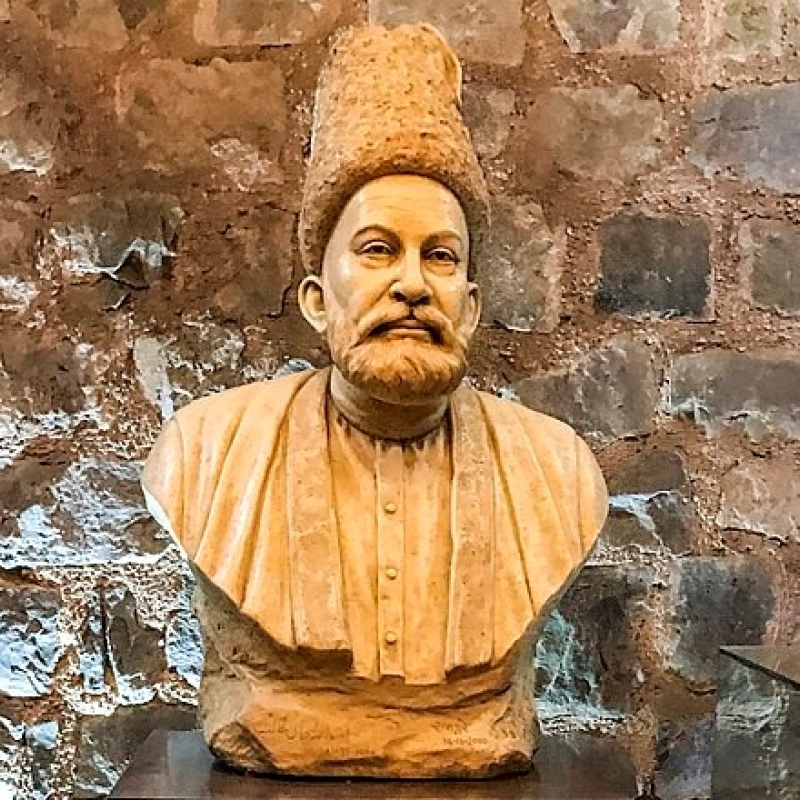Mirza Ghalib is a household name in the Indian subcontinent—a figure who is synonymous with Persian and Urdu poetry. The timeless nature of his verses and the universality of his themes have resulted in his works transcending borders and languages. Thanks to translations of Ghalib's ghazals to English by American literary giants such as Adrienne Rich, Robert Bly and W.S. Merwin, ghazals have found a prominent place in American literary traditions. (Photo Source: Indrajit Das/Wikimedia Commons)
In the Indian subcontinent, Mirza Ghalib’s name resonates with Urdu and Persian ghazals. Even though Ghalib wasn’t fully appreciated during his own time, he somehow managed to find a place in history after his death. The 19th-century poet was considered ahead of his own time and is revered as one of the greatest Urdu poets from the Indian subcontinent. Perhaps because of the timeless nature of his evergreen verses, he managed to permeate American poetry and has found a place in American literary traditions.
Since Edward Fitzgerald transcreated Omar Khayyam’s Rubaiyat in 1859, translators from the West have constantly tried to unveil Indo-Islamic traditions of poetry. The interest in Persian ghazals was first shown by German translators and poets such as Johann Wolfgang Goethe, Joseph von Hammer-Purgstall, Friedrich Ruckert and August von Platen, who had started translating ghazals by poets like Hafiz into German when Ghalib was still alive. By the 20th century, Federico Garcia Lorca, the Spanish poet had already popularised ghazals (or gacelas as he called them) in Spanish through his collection Diwan del Tamarit (1940)—a result of his Moorish heritage and background. However, the form finally caught the attention of American poets and entered the framework of American poetry through Ghalib.
Ghalib in America
On Ghalib’s centennial death anniversary in 1969, Aijaz Ahmad—a Pakistani critic residing in New York—edited Ghazals of Ghalib in order to familiarise the American audience with Ghalib’s timeless verses and place the 19th-century poet’s thoughts in the modern English language. Rather than a translation project, this was translation as ‘an encounter of ages and histories, across time, space, civilizations’ and as means for poets to ‘converse with each other, again across time, traditions and languages’.[i] Ahmad handed out literal translations and lexical notes to revered American translators and poets such Adrienne Rich, W.S. Merwin, David Ray, Mark Strand, and William Hunt, who were free to choose whatever method of translation that suited them the best.
Since the publication of 'Ghazals of Ghalib' 50 years ago, the interest in Mirza Ghalib's poetry has grown exponentially (Photo Source: Wikimedia Commons)
Ahmad’s aim was to take Ghalib, and not the ghazal in its lyrical capacity to the West, so the translators weren’t asked to adhere to the formal structure of the ghazal and had the freedom to use free verse. Ahmad emphasised that ‘translation is approximation’ and that ‘one translation might capture what another misses’.[ii] There was a multiplicity of responses in the book since multiple poets translated the same ghazal. Reminiscent of Eliot Weinberger’s project Nineteen Ways of Looking at Wang Wei (1987), where he commissioned 19 translators to translate the same poem, the results were fascinating. The three translation of Ghalib’s couplet ‘Vahshat-e-atish-e-dil se shab-e-tanhai mein / Surat-e-dud raha saaya gurezan mujh se’ read:
In the lonely night because of the anguish
of the fire in my heart
the shadow slipped from me like smoke
(W.S. Merwin)
Through the bonfire my grief lit in that darkness
the shadow went past me like a wisp of smoke
(Adrienne Rich)
That lonely night fire inhabited my heart
And my shadow drifted from me in a thin cloud of smoke.
(Mark Strand)
Ghazals of Ghalib (1969) [iii]
The Breaking of Form
The translations were a manifestation of Harold Bloom’s views that ‘freedom, in a poem, must mean freedom of meaning, the freedom to have a meaning of one’s own’.[iv] However, this emancipation of the essence by crushing the form was seen as misappropriation. Ahmad’s approach was questioned by many poets and scholars from South Asia such as Pariksith Singh, who raised crucial questions about loyalty to the text and the authenticity of the results and remarked, ‘to me, this is like calling a fourteen-line poem a sonnet’.[v]
Also Watch | Prof Abul K Qasmi on Mirza Ghalib
Even though the approach was questioned, its effect was acknowledged by everyone. The collection of poetry essentially created a butterfly effect. Poets such as Adrienne Rich, Phyllis Webb and John Hollander picked up the form and started writing ghazals in English, incorporating feminist themes and anti-war sentiments of the 1970s into their ghazals. By the time Agha Shahid Ali transformed ghazal writing in America in the late 1990s—bringing back the formal structure by employing traditional Urdu and Persian devices such as mazmun-affrini (theme creation), the qafia (rhyme scheme), and the radif (refrain)—ghazals had become a prominent form of poetry in the United States.
American scholar Francis W. Pritchett has dedicated years of her life to preserving Ghalib’s entire collection of poetry and legacy through her project ‘A Desertful of Roses’ (Video Source: Hindi Urdu Flagship/Youtube)
Going Forward
Since the publication of Ghazals of Ghalib 50 years ago, the interest in his poetry has grown exponentially. Christopher Merrill, the director of the International Writing Programme at the University of Iowa, goes as far as to say that ‘ghazal in today’s time has become a staple form of poetry that every MFA student has to endure’.[vi] The credit goes to Ghalib’s thought, his language of loss and expression of grief that sustained and managed to stay relevant in a different time, a different language system and different land.
Also Read | Mirza Ghalib and his Poetry
American scholars such as Francis W. Pritchett—who has dedicated years of her life to preserving Ghalib’s entire collection of poetry and legacy through her project ‘A Desertful of Roses’—have started looking to the East more carefully. In recent years, various poets and translators have attempted to translate Ghalib’s ghazals to English again in order to find new meaning. Andrew McCord’s brilliant translations of Ghalib’s ghazals—where he manages to incorporate the rhyme scheme and refrain, while bringing out the essence—is an example of America’s continued fixation with Ghalib. The couplets from McCord’s translation of Ghalib’s ghazal ‘Lazim Tha ke Dekho Mera Raasta Koi Din Aur’ read:
|
miT jā.egā sar gar tirā patthar na ghisegā aa.e ho kal aur aaj hī kahte ho ki jā.ūñ jaate hue kahte ho qayāmat ko mileñge haañ ai falak-e-pīr javāñ thā abhī aarif tum māh-e-shab-e-chār-dahum the mire ghar ke tum kaun se the aise khare dād-o-sitad ke mujh se tumheñ nafrat sahī nayyar se laḌā.ī guzrī na bahar-hāl ye muddat ḳhush o nā-ḳhush nādāñ ho jo kahte ho ki kyuuñ jiite haiñ 'ġhālib' |
And I say to the ancient sky, “Arif was still young and knowing. |
(Andrew McCord, ‘Four Ghazals by Mirza Ghalib’)[vii]
It is only natural that from here on, Ghalib’s influence will only grow in the West. Robert Bly’s collection The Lightning Should Have Fallen on Ghalib (1999) and Russel Ralph’s The Seeing Eye: Selections from the Urdu and Persian Ghazals of Ghalib (2003) are a testament to the fact that Ghalib’s verses have reinvigorated formal poetry in the West, and in doing so, has found a place in the American literary consciousness.
Notes
[i] Aijaz Ahmad, 'Ghalib: The Dew Drop on the Red Poppy', Mahfil, no. 4 (1968): 59–69.
[ii] Aijaz Ahmad, Introduction to Ghazals of Ghalib, ed. Aijaz Ahmad, (New Delhi: Oxford University Press, 1994), xv.
[iii] ibid.
[iv] Harold Bloom, 'The Breaking of Form', in Deconstruction and Criticism, ed. Harold Bloom, (New York: A&C Black, 2004), 3.
[v] Lisa Sewell, 'The Free verse and the Formal: The English Ghazal', in The Companion to Poetic Genre, ed. Erik Martiny. (New Jersey: Wiley-Blackwell, 2012), 104–117.












